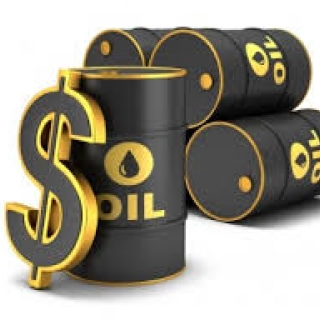


Oil rose more than 1% on Monday on signs of strong demand, shrugging off the impact of a bigger-than-expected OPEC+ output increase for August and concerns about the potential impact of U.S. tariffs.
Brent crude futures rose 79 cents, or 1.2%, to $69.08 by 2:05 p.m. ET (18:05 GMT). U.S. West Texas Intermediate crude was at $67.29, up 29 cents, or 0.4%. The benchmarks had dropped to $67.22 and $65.40, respectively, earlier in the session.
"The supply picture is clearly improving, however, stronger demand remains above expectations as well," Dennis Kissler, senior vice president of trading at BOK Financial, said. Travel industry statistics show a record number of Americans will be traveling for the Independence Day holiday by land and air.
The Organization of the Petroleum Exporting Countries and its allies, a group known as OPEC+, agreed on Saturday to raise output by 548,000 barrels per day in August, more than the 411,000 barrels per day they made over the previous three months.
The OPEC+ decision will bring back nearly 80% of the voluntary cuts of 2.2 million barrels per day from the eight OPEC producers to the market, RBC Capital analysts, led by Helima Croft, said in a note.
However, the actual production increase so far has been smaller than planned and most of the supply has come from Saudi Arabia, analysts said.
In a show of confidence about oil demand, Saudi Arabia on Sunday raised the price of its flagship Arab Light crude in August to a four-month high for Asia.
Goldman analysts expect OPEC+ to announce a final increase of 550,000 barrels per day for September at its next meeting on Aug. 3.
Oil prices also came under pressure as U.S. officials signaled a delay in when tariffs would kick in but failed to provide details on what changes would be made. Investors worry that higher tariffs could slow economic activity and oil demand.
The United States will make several trade announcements in the next 48 hours, Treasury Secretary Scott Bessent said Monday, adding that his inbox was full of final offers from countries to reach a tariff deal before a July 9 deadline.
"While U.S. trade policy is still in the works, the U.S. extending the deadline and moving away from punitive tariffs has helped lift some of the demand gloom that has prevailed since April," said Jeffrey McGee, managing director of advisory firm Makai Marine Advisors.
Meanwhile, geopolitical uncertainty persists. Yemen's Iran-aligned Houthi group said Monday that a cargo ship they attacked with gunfire, rockets and explosive-laden remote-controlled boats had sunk in the Red Sea, their first known attack on the high seas this year.
Israeli Prime Minister Benjamin Netanyahu will meet with Trump at the White House on Monday, as Israeli officials hold indirect talks with Hamas aimed at reaching a U.S.-brokered Gaza ceasefire and a hostage release deal. Iranian President Masoud Pezeshkian said he believed Iran could resolve its differences with the United States through dialogue, but trust would be an issue after U.S. and Israeli attacks on his country, according to an interview released on Monday. (alg)
Source: Reuters
Crude prices recovered from a midday dip on Friday on hopes Hungary can use Russian crude oil as U.S. President Donald Trump met Hungary's Prime Minister Viktor Orban at the White House. Brent crude ...
Oil prices rose on Friday (November 7th), but remained on track for a second straight weekly loss after three days of declines on oversupply concerns and slowing US demand. Brent crude rose 60 cents,...
Oil prices edged higher but remained on track for a second weekly decline. West Texas Intermediate (WTI) briefly approached $60 per barrel, while Brent held steady around $63 on Thursday. However, bot...
Oil prices declined on Thursday as investors considered a potential supply glut, as well as weakened demand in the United States, the world's largest oil consumer. Brent crude futures settled down 14...
Oil prices edged higher on Thursday (November 6), boosted by easing concerns over a potential oversupply as sanctions against Russian companies began to take effect. After closing at a two-week low i...
Crude prices recovered from a midday dip on Friday on hopes Hungary can use Russian crude oil as U.S. President Donald Trump met Hungary's Prime Minister Viktor Orban at the White House. Brent crude futures settled at $63.63 a barrel, up 25 cents...
US stocks rebounded from early losses to close mostly higher on Friday amid hopes that Congress members were making progress toward ending the government shutdown. The S&P 500 and the Dow Jones closed 0.3% higher, while the tech-heavy Nasdaq...
European stocks fell on Friday as investors digested more quarterly earnings, but weekly losses were inevitable, with concerns regarding overheated valuations evident. The DAX index in Germany dropped 0.8% and the CAC 40 in France declined 0.2%,...
 The Institute for Supply Management (ISM) is scheduled to release its October Services Purchasing Managers' Index (PMI) on Wednesday. The report, a...
The Institute for Supply Management (ISM) is scheduled to release its October Services Purchasing Managers' Index (PMI) on Wednesday. The report, a...
 The ISM Services PMI rose to 52.4 in October 2025 from 50 in September, beating forecasts of 50.8, pointing to the strongest expansion in the...
The ISM Services PMI rose to 52.4 in October 2025 from 50 in September, beating forecasts of 50.8, pointing to the strongest expansion in the...
 European stocks opened lower on Wednesday (November 5th), reflecting a global downturn amid growing concerns over sky-high tech valuations.
The...
European stocks opened lower on Wednesday (November 5th), reflecting a global downturn amid growing concerns over sky-high tech valuations.
The...
 Asian markets opened higher, following Wall Street's rebound. The Nikkei and Kospi jumped around 1% at the open, while US stock futures fluctuated...
Asian markets opened higher, following Wall Street's rebound. The Nikkei and Kospi jumped around 1% at the open, while US stock futures fluctuated...